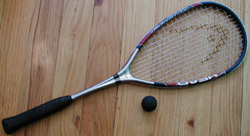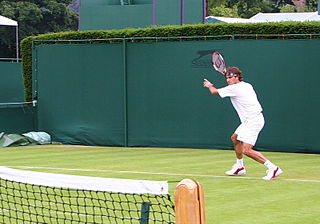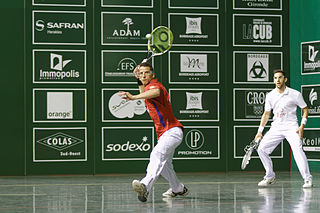
Badminton is a racquet sport played using racquets to hit a shuttlecock across a net. Although it may be played with larger teams, the most common forms of the game are "singles" and "doubles". Badminton is often played as a casual outdoor activity in a yard or on a beach; formal games are played on a rectangular indoor court. Points are scored by striking the shuttlecock with the racquet and landing it within the other team's half of the court.

A racket or racquet is an item of sporting equipment used to strike a ball or shuttlecock back-and-forth in games such as tennis, badminton, squash, racquetball and padel. The typical basic structure of a racket consists of a widened distal end known as the head, an elongated handle known as the grip, and a reinforced connection between the head and handle known as the throat or heart.
Yonex Co., Ltd. is a Japanese sports equipment manufacturing company. Yonex produces equipment and apparel for tennis, badminton, golf, and running.
Babolat is a French tennis, badminton, and padel equipment company, headquartered in Lyon, best known for its strings and tennis racquets which are used by professional and recreational players worldwide. The company has made strings since 1875, when Pierre Babolat created the first strings made of natural gut. Babolat continued to focus on strings until 1994, when it became a "total tennis" company, producing also racquet frames and selling them in Europe. It then expanded sales to Japan, and later to the United States in 2000. Sales of Babolat racquets increased rapidly in North America and Europe. Babolat is also a pioneer in connected sport technology and launched a connected tennis racket in 2014 and a connected wrist-worn tennis wearable with PIQ in 2015. The Babolat Pop is used worldwide, and one of the leaders in tennis sensors.

Rackets or racquets is an indoor racket sport played in the United Kingdom, United States, and Canada. It is infrequently called "hard rackets" to distinguish it from the related sport of squash.
In tennis, a grip is a way of holding the racquet in order to hit shots during a match. The three most commonly used conventional grips are: the Continental, the Eastern and the Semi-Western. Most players change grips during a match depending on what shot they are hitting.

The forehand in tennis and other racket sports such as table tennis, squash and badminton is a shot made by swinging the racket across one's body with the hand moving palm-first. In tennis, except in the context of the phrase forehand volley, the term refers to a type of groundstroke—a stroke in which the ball has bounced before it is struck. It contrasts with the backhand, the other type of groundstroke. For a right-handed player, the forehand is a stroke that begins on the right side of the body, continues across the body as contact is made with the ball, and ends on the left side of the body. It is considered the easiest shot to master, perhaps because it is the most natural stroke. Beginners and advanced players often have better forehands than any other shots and use it as a weapon.
Howard Head was an American aeronautical engineer who is credited with the invention of the first commercially successful aluminum laminate skis and the oversized tennis racket. Head founded the ski -making firm, Head, in 1950. Later, he became chairman of Prince Manufacturing Inc. The U.S. patents for the laminate skis and oversized tennis racket are in the name of Howard Head. He graduated from Harvard College in 1936.

Matkot is a popular Padel ball game in Israel similar to beach tennis, often referred to by Israelis as their national beach sport.

Prince Global Sports, LLC is an American sporting goods manufacturing company based in Atlanta, Georgia. Founded in 1970, Prince's range of products includes rackets, footwear, apparel, tennis balls, pickleball paddles, stringing machines, hats and bags.

Frontenis is a sport that is played in a 30 meter pelota court using racquets and rubber balls. It can be played in pairs or singles, but only pairs frontenis is played in international competitions. This sport was developed in Mexico around 1900, and is accredited as a Basque pelota speciality.
In tennis, the strings are the part of a tennis racquet which make contact with the ball. The strings form a woven network inside the head of the racquet. Strings have been made with a variety of materials and possess varying properties that have been measured, such as dynamic stiffness, tension retention, thickness (gauge), string texture, and rebound efficiency.

The Wilson Pro Staff Original, first introduced in 1984 is most known for being the model of racquet used by Pete Sampras. For this reason, it is known as a “Sampo”.
Head Sport GmbH is an American-Austrian manufacturing company headquartered in Kennelbach. It owns the American tennis racket brand Head. Head GmbH is a group that includes several previously independent companies, including the original "Head Ski Company" ; Tyrolia, an Austrian ski-equipment manufacturer; and Mares, an Italian manufacturer of diving equipment.
Since the sport's inception, the design and manufacture of tennis equipment has been affected by technological advances and regulations. As is common in major sports, regulations became more exacting over time, with improvements affecting the qualities of the tennis racket and the tennis ball.
The Prince original graphite, or the "POG" as it is called, or "The Original G" is a tennis racquet manufactured by Prince Sports. It was first introduced in 1980 and has been used by numerous world-class tennis players, including Andre Agassi, Michael Chang, Gabriela Sabatini, and Monica Seles.
Ektelon, Inc. was an American manufacturer of equipment for racquetball.

ProKennex is a Taiwanese manufacturer of racquet sports equipment for tennis, squash, badminton, racquetball, and pickleball. The company enjoyed wide global distribution in the 1980s, when manufacturing in Taiwan was booming due to domestic economic conditions. Parent company Kunnan Enterprise Ltd. has faced financial difficulties since the mid 1990s, leading to a contraction of the ProKennex name globally. Today, the company focuses on a niche set of consumers interested in technology advancements in racquet sports. The company focuses on this aspect of its products by promoting itself as a "science and design company", rather than a standard racket manufacturer.

The "spaghetti" racquet was a type of double-strung tennis racquet that had a brief spike in popularity in the fall of 1977, revolutionizing the sport for about a month before being banned at the top levels of play. It applied far more spin to a tennis ball than conventionally strung racquets, leading to disorienting movements through the air, especially after bounces.

The Alexander Patent Racket Company was an Australian sports equipment manufacturer based in Launceston, Tasmania, which operated between 1925 and 1961.











